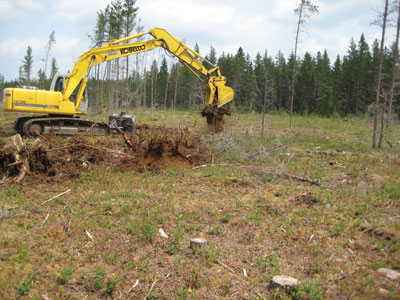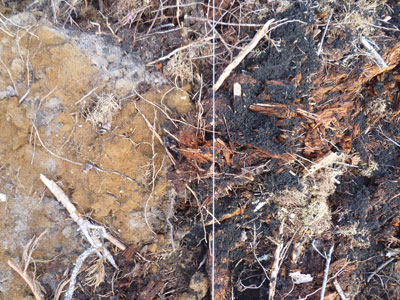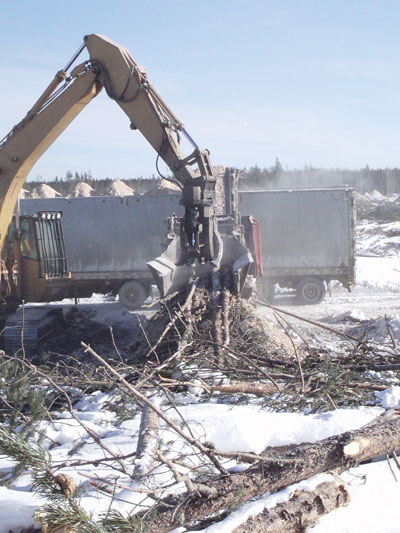
Tembec Building Biomass Knowledge
June 4, 2012
By Paul Hazlett Dave Morris and Rob Fleming
A comprehensive biomass harvesting experiment is taking place in northeastern Ontario thanks to Tembec Chapleau Operations.
A comprehensive biomass harvesting experiment is taking place in northeastern Ontario thanks to Tembec Chapleau Operations. The Island Lake Biomass Harvest Research and Demonstration Area in the Martel Forest is a collaborative project designed to examine the impacts of intensified biomass harvesting and provide a venue where forest community members can observe and learn about the process. Project results will be used to refine forest management guidelines to ensure forest sustainability.
 |
|
| Some of the experimental treatments consisted of stump removal to gauge the severity of various stages of biomass harvest. Photo: Beatrix Schwarz |
Tembec has teamed with community partners, the Northeast Superior Forest Community (NSFC) and the Northeast Superior Regional Chiefs’ Forum (NSRCF) in addition to Ontario Power Generation (OPG), FP Innovations, Forest Research Partnership (FRP), Ontario Ministry of Natural Resources (OMNR) and Natural Resources Canada – Canadian Forest Service (NRCan-CFS) to implement this large-scale field experiment.
Canada’s forest bioeconomy is developing at a rapid pace and in the coming years, may become an even more important part of local forest economies.
Currently, a seven-megawatt wood-fired thermal electric generating facility at the Tembec Chapleau site provides electricity to the Ontario grid and steam for sawmill operations. Stakeholders in forest communities across Canada and around the world are concerned about the possible long-term impact of biomass harvesting on long-term site productivity and biodiversity, and therefore thoughtful initiatives are required to steer bioeconomy research to ensure that forests remain healthy and sustainable.

|
|
| Tembec Chapleau provided wood ash waste from the cogeneration plant to apply at various levels to the additional full-tree biomass harvested plots. |
Scientists from the NRCan-CFS Great Lakes Forestry Centre in Sault Ste. Marie and the OMNR Centre for Northern Forest Ecosystem Research in Thunder Bay are co-leading research activities at the Island Lake site, where an irregularly spaced 40-year-old limby jack pine stand on a sandy, glaciofluvial outwash soil was targeted. While these site types have flat terrain and all-season accessibility well suited to more intensive utilization, there are concerns that intensive biomass removal may result in excessive nutrient depletion and loss of woody debris that has high value for biodiversity.
The overall silvicultural objective of the project was to provide stand improvement through biomass harvesting of the 40-hectare block, followed by site preparation, planting and vegetation control.
Harvesting at the site recovered 5040 m3 of tree-length sawlogs (10% over forecast) and this was complemented with grinding and hauling of 4373 green metric tonnes of previously unutilized biomass (more than 100% over forecast).
During 2011, Tembec Chapleau led operations to provide experimental plot treatments that spanned the broad range of potential biomass harvest intensities using the clearcut silvicultural system.
 |
|
| Grinding complemented harvesting and hauling previously unutilized biomass (more than 100% over forecast). |
These included tree-length (stem-only) harvest, full-tree operational commercial biomass harvest (including unmerchantable material as well as tops and branches), full-tree biomass harvest plus stump removal and full-tree biomass harvest with removal by blading of coarse woody debris (standing and downed), stumps and forest floor. Increased utilization of the aboveground portion of the forest stand during full-tree operational harvest was the most likely scenario for biomass harvesting, and was therefore applied across the harvest block outside the core experimental plots.
To add greater value to the overall project, Tembec Chapleau also provided wood ash waste from the cogeneration plant to apply at various levels to the additional full-tree biomass harvested plots.
In this supplementary experiment, the application rates were selected with the goal of fully replacing the additional nutrients removed by the full-tree biomass harvest, as well as providing it at one quarter, one half and two times this amount.
Wood ash waste is currently landfilled at a cost to the forest industry, but site remediation using it could potentially maintain or increase soil fertility and forest productivity as well as save on disposal costs. The research is also addressing the concern that wood ash waste applied as a soil amendment could have adverse effects on water and biodiversity in forest ecosystems.
Working with skilled harvest operators and the OMNR, Tembec Chapleau was also able to test the practical implementation of new Stand and Site guideline residual retention parameters during the harvest at the Island Lake site.
A portion of the stand left as residuals was stubbed during harvest operations to provide wildlife trees and emulate the physical properties of trees killed by wildfire.
Researchers are now commencing to evaluate the productivity and biodiversity responses to the treatments, and will continue to do so at various times throughout the course of stand development.
 |
|
| Researchers are evaluating the productivity and biodiversity responses to the various stand treatments. Photo: Paul Hazlett |
Measurements will include tree growth, soil properties, water quality, plant community dynamics, microbial processes and terrestrial fauna. Long-term monitoring is a critical component of this type of experiment as physical, chemical and biological constraints to productivity and biodiversity vary over time. The impacts of intensified biomass removal detected early on in stand development may diminish or increase as trees grow.
For example, seedlings have low soil nutrient demands in the early years after establishment, but after the canopy closes and demand increases, further nutrient limitations to growth could be detected.
Results from this project will provide insight into potential harvest and mitigation treatment responses and effects, as well as making important scientific contributions to clarify the implications and opportunities for biomass harvesting in Ontario and abroad.
Print this page